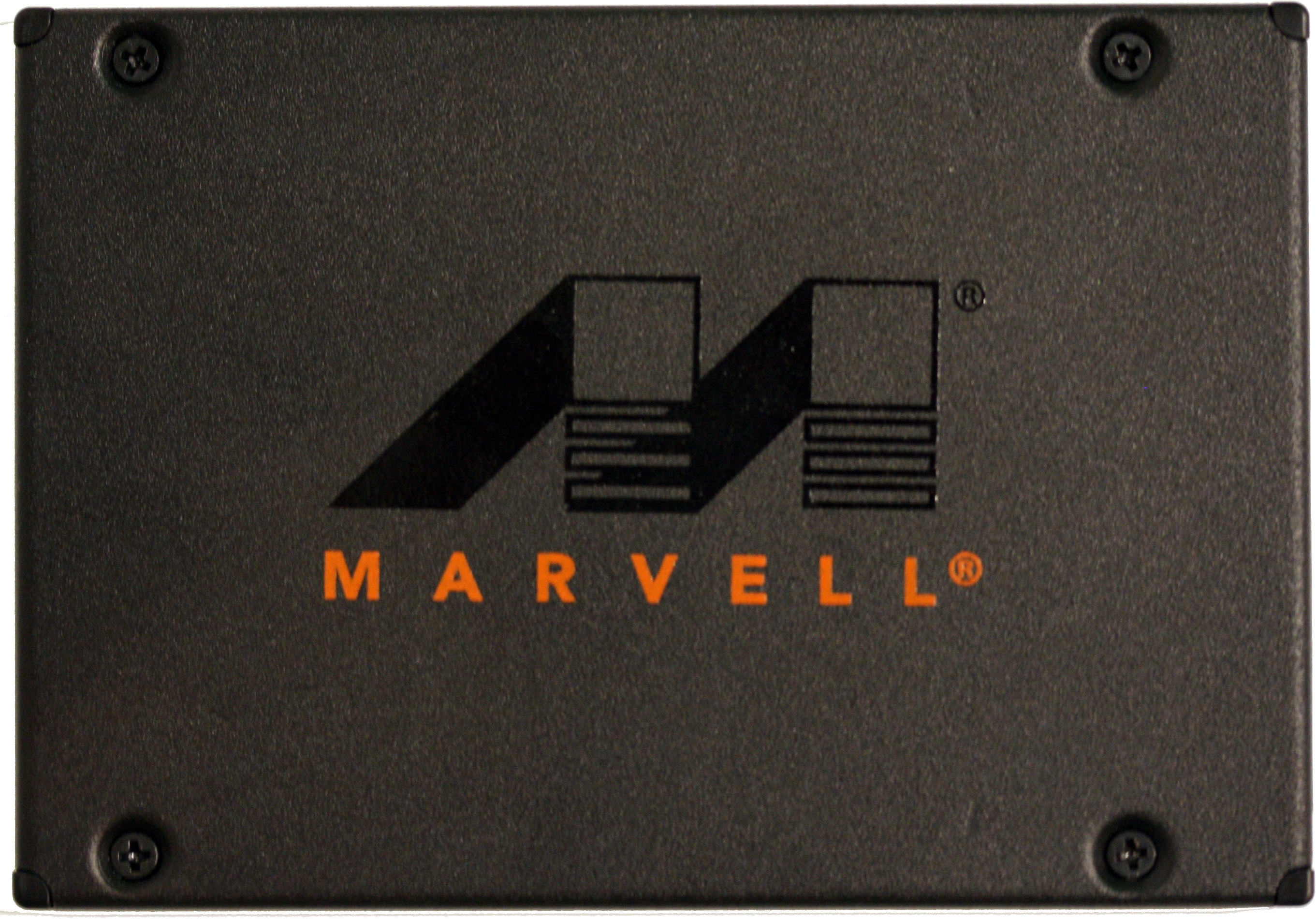6 Gb/s SATA: Seagate’s Barracuda XT And Marvell’s SSD Controller
Coming Soon: 6 Gb/s SSDs
Coming Soon: 6 Gb/s SSDs
Realizing that 6 Gb/s transfer rates will not benefit mechanical drives as much as higher areal density (at least when you’re talking about individual drives—naturally, more bandwidth per-port is great when you’re using a multiplier to attach multiple drives), we hang our hopes for better performance on the next generation of SSDs.
I’m not even going to attempt to go into the depth of SSD performance covered by my friend Anand in his latest SSD roundup (especially with less than 10 hours now before a flight to Spain). Suffice it to say, the current crop of solid state drives is, in sequential read tests, able to tax a 3 Gb/s link. The next generation of SSDs should push this boundary even further.
The 6 Gb/s controller we got our hands on is, as mentioned, very preliminary. Though the 2.5” chassis looks like an actual SSD, we opened it up and found no flash memory inside of it (unfortunately, we’re also unable to show a picture of the controller itself or the Micron DDR2-667 memory buffer under the hood at this point; protecting the innocent, and all of that).
We can’t exactly test this device against a retail product. After all, the performance of an SSD based on this particular controller will ultimately be bound by the NAND flash configuration vendors use in their designs. From what we’ve heard, however, some of the next-gen flash engineering samples (in the right configuration) will be able to saturate a 6 Gb/s port. Of course, the burden is on drive vendors to actually show us this performance.
For now, all that we’re able to do is test the maximum performance of Marvell’s controller on a 6 Gb/s port and a 3 Gb/s port, hopefully realizing a significant performance jump from the latter to the former.
| Header Cell - Column 0 | 3 Gb/s Intel Controller | 6 Gb/s Marvell Controller | 3 Gb/s Intel Controller (Intel 160GB Gen2 SSD) |
|---|---|---|---|
| Linear Read (Beginning) | 241.3 MB/s | 377.3 MB/s | 241.5 MB/s |
| Linear Read (Middle) | 241.5 MB/s | 377.3 MB/s | 241.3 MB/s |
| Linear Read (End) | 241.5 MB/s | 377.7 MB/s | 241.4 MB/s |
| Random Read | 300.6 MB/s | 430.7 MB/s | 247.0 MB/s |
| Read Access | .13 ms | .16 ms | .10 ms |
Everest shows us a significant gain in shifting from the 3 Gb/s port to Marvell’s own 6 Gb/s SATA controller. Of course, we should also point out that the observed linear read numbers at 3 Gb/s aren’t as high as some of the results we’ve seen from shipping SSDs, so there’s likely additional optimization to be done within Marvell’s firmware.
Get Tom's Hardware's best news and in-depth reviews, straight to your inbox.
But the shift to a 6 Gb/s link is telling indeed. Linear read speed jumps from 241 MB/s or so up to 377 MB/s. And random read speed goes from 300.6 MB/s (basically the maximum interface speed of SATA 3 Gb/s) to 430.7 MB/s.
Naturally, because there is no flash memory here, we can’t yet test write performance, which will undoubtedly be lower.
| Header Cell - Column 0 | 3 Gb/s Intel Controller | 6 Gb/s Marvell Controller | 3 Gb/s Intel Controller (Intel 160GB Gen2 SSD) |
|---|---|---|---|
| Burst Read Performance | 249 MB/s | - | 258 MB/s |
| Average Sequential Read Performance | 219.9 MB/s | 303.2 MB/s | 225.7 MB/s |
| Access Time | .1 ms | .2 ms | .1 ms |
Average sequential read performance in HDTach jumps from 219 MB/s to 303 MB/s in making the move from 3 Gb/s to 6 Gb/s. For comparison, Intel’s second-gen X25-M drive achieves 225.7 MB/s.
Remember that SSDs based on Marvell’s controller will be limited by flash memory bandwidth. So, again, we’re inclined to suspect that there is plenty of optimization left to do, based on the performance of Marvell’s controller compared to Intel’s complete drive attached to a 3 Gb/s port.
With that said, there still looks to be a sizeable gain in moving from 3 Gb/s to 6 Gb/s SATA.
-
cyberkuberiah 32nm lynnfields of tomorrow should have 16 lanes but of pcie3 , so that x8 pcie 3.0 crossfire becomes comparable to x16 pcie 2.0 crossfire of today , as mainstream , because just to buy a quality motherboard with dual x16 2.0 means at least $70+ more in intel compared to 790fx+sb750 motherboards . pcie3 was due but got delayed , i sceptically wonder why .Reply -
huron I was looking for SATA 6Gb/s and USB 3.0 on my next motherboard. I hear there are some in the works for next year. I look forward to this being more common sometime in the near future.Reply -
WheelsOfConfusion Trips to Spain, constantly upgrading home theater setups, filling your NAS until you need an overkill solution, we get it Chris, you're filthy rich. >:PReply -
dcuccia Not sure I totally understand...does the Marvell controller support RAID? Couldn't you bandwidth test RAID0 configurations with the Intel G2 drives?Reply -
Belardo I WANT IT!!!Reply
My next mobo MUST have:
SATA 3.0 6GB/s and USB3.0... PCIe 3.0 would be a bonus.
-
avatar_raq I would like to see a comparison between ASUS Maximus II Extreme (x58) and P7P55D Deluxe SATA III controllers to see if the P55 one truly has a bottleneck affecting the drive performance.Reply -
cangelini WheelsOfConfusionTrips to Spain, constantly upgrading home theater setups, filling your NAS until you need an overkill solution, we get it Chris, you're filthy rich. >Reply
Hah, I wish! Just fortunate to be able to work with some cool people and cool hardware. First real vacation since my honeymoon almost five years ago!
Cheers from Barcelona!
Chris

